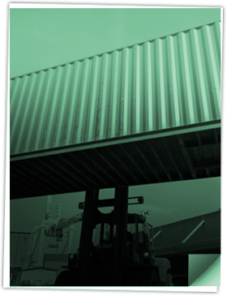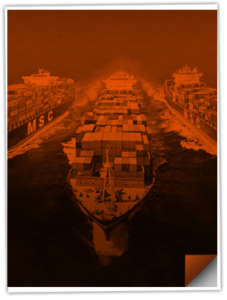Featured Headlines:
BIS Grants 3 New Export Wishes
FDA Feeding Tube Now On YouTube
Forward Air Merger Heading Backwards
You Can’t Ship Out In a Drought
Something Smells Fishy in Xinjiang…
BIS Grants 3 New Export Wishes
- On October 17, 2023, the U.S. Department of Commerce’s Bureau of Industry and Security (BIS) released a package of rules designed to update export controls on advanced computing semiconductors and semiconductor manufacturing equipment, as well as items that support supercomputing applications and end-uses to arms embargoed countries—such as the People’s Republic of China (PRC)—and to place additional PRC-related entities on the Entity List.
- Here are the three rules:
- The rules reinforce the controls placed on October 7, 2022 restricting the PRC’s ability to both purchase and manufacture certain high-end chips critical for military advantage.
- These include the following: Advanced Computing Chips Rule (AC/S IFR), Circumvention Prevention, Expansion of Export Controls on Semiconductor Manufacturing Items Interim Final Rule, and the Additions to the Entity List.
- BIS officials are encouraging exporters to review the rules in detail; and to submit comments as requested.
- For a more detailed fact sheet, click here.
- Any questions? Feel free to reach out to our compliance experts!
Calling the VSD Authorities
- If you believe that you may have violated the Export Administration Regulations (EAR)—or any order, license, or authorization issued thereunder for that matter—the BIS is strongly encouraging you to submit a Voluntary Self Disclosure (VSD) to its Office of Export Enforcement (OEE).
- Shippers should note the following points about VSDs:
- A VSD is a mitigating factor in determining what administrative sanctions, if any, will be sought by OEE.
- The weight given to VSDs is solely within the discretion of OEE, and the mitigating effects may ultimately outweigh the aggravating factors.
- A firm will not be deemed to have made a disclosure under this section unless the individual making the disclosure did so with the full knowledge and authorization of the firm’s senior management.
- Any person wanting to disclose information that constitutes a VSD should, in the manner outlined below, initially notify OEE as soon as possible after violations are discovered, and then conduct a thorough review of all export-related transactions where violations are suspected.
- The notification should describe the general nature and extent of the violations. It should also indicate the name of the person making the disclosure, a brief description of the suspected violations, and a designated contact person. This includes the contact person’s current business street address, email address, and telephone number.
- If a shipment leaves the United States without the required license, yet there is still an opportunity to prevent the acquisition of the items by unauthorized persons, alert OEE by phone immediately.
- BIS is now accepting the following electronically: VSDs, exhibits, and requests for filing deadline extensions. Submissions can be directed to [email protected].
- Hard copy filing is not required in addition to electronic filing. Please be aware that receipt and processing delays may occur in instances where only a hard copy VSD is submitted.
- Remember, review all disclosures carefully with legal and file in a timely manner. If you file after BIS initiates an investigation, you may not get any mitigation of the penalty.
- Refer to the BIS website for additional information on disclosures under 764.5 of the EAR.
FDA Feeding Tube Now On YouTube
- The U.S. Food and Drug Administration (FDA) has released a YouTube video on the FDA’s Import Process for Human Foods. This video will assist individuals, businesses, and governments in navigating the importation of food and food items into the United States while maintaining the food is safe and compliant.
- As a refresher, the FDA regulates all foods and food ingredients except for meat, poultry, certain processed egg products and catfish. These items are regulated by the U.S. Department of Agriculture (USDA).
- To import food products successfully, an importer should know a literal smorgasbord of information concerning their products and their suppliers.
- This video will provide information on the FDA Import Process, including:
- Researching the Requirements:
- Food Facility Registration
- Food Safety Standards
- Labeling and Nutrition
- Prior Notice
- Additional Requirements
- Declaring the Shipment
- FDA Admissibility Decision
- Researching the Requirements:
- This is the second video in the “importing FDA-regulated products” series. You can watch it here: Importing FDA-Regulated Products: Human Foods.
- The first video published in this series is also available here: Importing FDA-Regulated Products: the Import Process.
- To view the full announcement, which includes links for additional FDA information, please view CSMS # 58071580.
Importers Enter New Portals
- U.S. Customs and Border Protection (CBP) launched a new portal that importers can use to file administrative petitions when seeking relief from any of the following:
- Notice of Penalty
- Liquidated Damages Incurred
- Demand for Payment
- Notice of Seizure
- Now, users can create a new petition and/or look up an existing one within the new CBP ePetition Application Portal.
- The FDA also opened a new Cosmetics Facility Registration Site on October 1st.
- The purpose of the new registration site is to give companies more time and flexibility to comply with registering their facilities producing FDA-regulated products.
- Additionally, FDA officials posted an overview of the cosmetics registration process, which will assist those impacted by the Modernization of Cosmetics Regulation Act (MoCRA).
- Are you challenged navigating the ACE legacy portal? Then you’re in luck, because Shapiro is hosting a complimentary webinar on the “old” platform before CBP fully launches its new and improved ACE portal. Spots are limited—click here to reserve your spot for our November 2nd session before it’s too late!
J.B. On an Intermodal Hunt
- J.B. Hunt Transportation believes they’ve spotted the light at the end of the freight tunnel. After a rocky ride, they’ve seen their volume rise by 1% year-over-year (YoY) in the third quarter, signaling the approaching end of the US freight recession. 1% may seem like dust in the wind but this comes after several quarters of decreasing volumes.
- Loads coming and going from the West Coast have been on a roll, rising by 4% YoY in the third quarter as well.
- Intermodal train speeds are also on the fast track, up over 4% YoY from January to October’s first week. They’re steaming toward success.
- The previously lowered volumes have also allowed freighters to get their punctuality game down. Over 91% of intermodal trains in the US have been right on time or less than 24 hours late. That’s a whopping seven percentage points better than last year!
- However, even with this volume on the rise, J. B. Hunt’s intermodal revenue hit a speed bump, declining by 15% YoY in the third quarter due to contract rates taking a double-digit dip across the US.
Forward Air Merger Heading Backwards
- Ancora Alternatives, the activist investor firm, is causing turbulence at Forward Air. They’re on a mission to overthrow the head honcho and derail the controversial merger with Omni Logistics.
- Ancora is gunning for a special shareholder meeting, with plans to replace Forward Air’s board members, including Tom Schmitt, the CEO, chairman, and president. They’re hoping to prevent the Omni acquisition, which they blame for the nosedive in Forward Air’s stock value.
- Lawsuits are flying faster than a runaway aircraft! The plaintiffs, a mix of shareholders and former executives argue that the Omni deal violates Tennessee laws. These laws demand a pre-close shareholder vote for agreements that transfer a significant chunk of a company’s assets or dilute existing shareholders by over 20%.
- Forward Air’s stock price has been on a wild ride, dropping about 32% since the Omni merger announcement. It’s like a stock market roller coaster, with shareholders gripping their seats!
- The planned $150 million merger would birth a $3.5 billion company, co-captained by Schmitt and Omni’s JJ Schickel. Omni, with its 40+ US service centers and range of services, seems like a good match. It’s like a transportation potluck with a dash of expedited, a sprinkle of drayage, and a pinch of customs brokerage in the mix.
Jet Set Trends
- Since well before Gutenberg gave us the printing press in 1436, western Europeans have been innovating, inventing, and solving the world’s great mysteries. Then, why do these same people insist on using week numbers in the shipping business?!
- Well anyway, we are at the end of Week 43 now (or so, the Danish and others tell us!), and we have some airfreight trends to share!
- On a global basis, chargeable kilos are down about 1% MTD for October vs. last year, but air rates are up nearly 3% globally. The airlines have been more selective with their use of freighter aircraft, which partially explains this betrayal of the laws of supply and demand.
- For the rest of the answer, we look to the land where gunpowder was invented by monks in the 800’s… yes, China!
- The China market is warm enough to boost global rate averages despite a small worldwide downtick in volume. Overall, Chinese airfreight volumes and prices are up just over 5% Y-o-Y, and airlines have been rather “stingy” to use all available freighters.
- Interestingly, if you look at China’s five largest airport gateways, Guangzhou and Shenzhen are up significantly Y-o-Y with Shanghai up just modestly while Hong Kong and Beijing are down.
- Not surprisingly, all five major Chinese air hubs saw major rate increases in Week 43 YoY for 2020 and again in 2021. 2022’s Week 43 was ALL decreases, and now, in 2023, our porridge is just right with mixed results across China.
- Despite the recent rate boost, worldwide rate averages for all of 2023 remain 33% below last year’s averages and a staggering 67% below the historic highs of January 2022.
- Follow Shapiro on LinkedIn to view our monthly Supply Chain Reaction posts, which include ocean, air and drayage rate updates!
You Can’t Ship Out In a Drought
- The Amazon River, an iconic waterway, is facing a crisis of epic proportions, reminiscent of Scar’s takeover of Pride Rock in “The Lion King,” with water levels dwindling to unprecedented lows. Here’s what’s happening and why it’s a matter of great concern.
- In a bid to adapt to the vanishing river flow, Brazilian grain exporters are having to change their routings. They are shifting cargo from the once bustling northern ports to the southern port terminals. This rerouting is poised to have far-reaching effects on the country’s exports.
- The drought isn’t merely impacting the shipping industry. Natives who depend on the Amazon River for their livelihood are now grappling with dire circumstances. The situation has become so severe that necessities like medicine, water, and food are being airlifted in.
- The port of Manaus, a key trading hub, is grappling with the lowest water levels seen since 1902. This historic low is causing disruption in shipping, trade, and the daily lives of those who rely on the river.
The EXIM—A United States Gem
- At the United States Export-Import Bank (EXIM), the 2023 fiscal year has unveiled a tale of remarkable success, with a resounding total of over $8.7 billion in financing.
- The bank’s resolute commitment to supporting U.S. exporters and bolstering American jobs has borne remarkable fruit since its reauthorization by Congress in 2019.
- The bank has thrown its weight behind hundreds of projects across the United States. Notably, they have been instrumental in driving growth in vital sectors like renewable energy, domestic manufacturing, transportation, and nuclear energy, all while staunchly supporting American small businesses.
- The EXIM is built around providing exporters with the tools they need to succeed. To facilitate the dreams of American businesses venturing into the global market, the bank offers a rich array of support including export credit insurance, working capital guarantees, loan guarantees, and direct loans.
Something Smells Fishy in Xinjiang…
- This week, US legislators issued a letter urging the Biden Administration to place restrictions on seafood imports from Chinese businesses utilizing forced labor practices within their supply chains— including those operating in the Xinjiang region.
- In the memo, Rep. Chris Smith (R, NJ) and Sen. Jeff Merkley (D, OR) cited a report released by an investigative journalism group—known as The Outlaw Ocean Project—that details the widespread allegations against seafood production facilities across China.
- In 2022, China produced 67.5 million tons of seafood products. Should Biden take action, the world’s largest seafood producer may soon find themselves in the very rough seas of intense regulation!
Trade Lane Swayed Pain
- How do you increase rates without robust demand? You cut 600,000 TEUs (and counting) from the transpacific trade in October, that’s how!
- By following the China National Day holiday with more capacity cuts, through blank sailings and service suspensions, the ocean carriers have created congestion at Asian ports, destabilized transits, and tripled US sales of aspirin, ibuprofen, and acetaminophen!
- We also expect this giant “spatial massage” to bump rates on November 1 by about 16% though we expect the big squeeze to be effective for maybe two weeks before rates dip again.
- THE Alliance, our friends O.N.E., Hapag Lloyd, Yang Ming, and Hyundai have removed their PN3 and EC4 services for the winter which reduces market potential volume by 13% to the Pacific Northwest and 7% to the US East Coast.
- The 2M and Ocean Alliance groups are also slow-cooking their winter stew of deployment changes though nothing has been officially placed on that menu to date.
- Adding to the merry party at origin, US West Coast demand is hanging in there more favorably than the other US trades. The Port of Los Angeles swaddled and delivered 14% more inbound containers and 55% more outbound loads YoY in September.
- A glance at the bigger picture is less favorable; through Q3, LA is down 19% vs. the first three quarters of 2022 and down 12% vs, their five-year average. At least from a shipping perspective, Tinseltown has been Lacklusterville.
- Is your supply chain suffering from trade lane pain? Reach out to our freight experts to see if Shapiro can help you to diagnose the problem.
Prince Rupert Port Project
- The Prince Rupert Port Authority (PRPA) embarks on the Ridley Island Export Logistics Project (RIELP), a groundbreaking venture expanding rail-to-container transloading at the Port of Prince Rupert.
- RIELP features a 108-acre greenfield development launching in Q3 2026, with Ray-Mont Logistics at the helm. It’s all about transloading 400,000 TEUs for agriculture, forestry, and plastic resin products, building on the success of a temporary location.
- It will also extend the Ridley Island Road Rail Utility Corridor, welcoming unit trains stretching 10,000 feet. Accessible via a direct private road and the Fairview-Ridley Connector Corridor, it aims to reduce truck drayage and boost decarbonization efforts.
- It also promises innovative opportunities for Canadian exporters to reach Asia Pacific markets.
- The PRPA has a goal of supporting the port’s stability and enhancing trade, employment, and economic opportunities (real shockers, here). The effort represents a total investment of $750 million and is primed to reshape the port’s future and the greenfield they are leveling.



